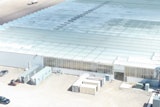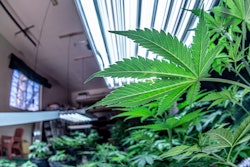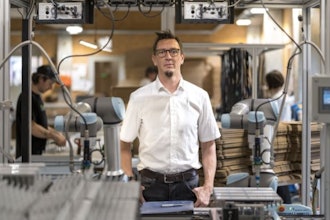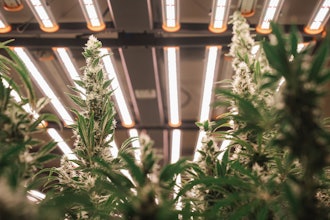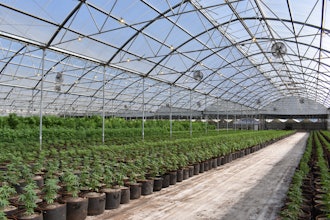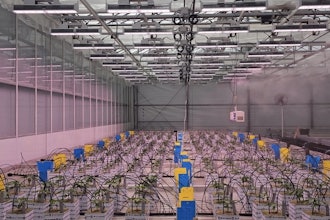![[5] Because DE eliminates nearly all conduit, it installs up to 80% faster than traditional AC power distribution, reducing labor costs and building times by weeks or months.](https://img.cannabisequipmentnews.com/files/base/indm/multi/image/2022/01/ACvDE_Final_Version_Page_8_Image_0006.61dddb744427e.png?auto=format%2Ccompress&q=70&rect=1%2C0%2C955%2C536&w=400)
The primary challenge for an indoor farm is to replace the sun, which provides an average of 1370 Watts per square meter, with lighting powered by electricity. So, it should be no surprise that the cost of the AC electrical infrastructure necessary to deliver light to plants can approach 50% of the total cost of the building, depending on the crop.
Specifically, the AC infrastructure cost includes the electrical materials, the LED driver (which is often built into the LED fixture and accounts for around 25% of the LED fixture cost), and the labor associated with installation. The single biggest contributor to overall cost is the installation labor, which accounts for approximately 55% of total cost.
Reduce installation costs, improve safety
Digital ElectricityTM (DE) replaces traditional AC power distribution equipment and the LED driver, its simple architecture reduces installation labor costs by around 80%. The result is up to a 40% reduction in the capital cost of distributing power to LEDs.
On top of that, by centralizing the driver, the DE system reduces the number of electrical components and connections by around 75%. This significantly increases system reliability, while improving airflow above the LEDs. DE is faster to install, easier to maintain, reduces electrical THD (which can reduce your electricity bill), and includes powerful software for both controlling photoperiod and light-zones definitions and monitoring LED performance.
Most importantly, DE provides additional safety for your employees and assets by providing line-to-ground and line-to-line touch fault and fire protection, without the need for GFCIs.
Why is DE so much less expensive to install?
Next, we illustrate why DE is so much faster and less expensive to install by summarizing the steps involved in installing both a traditional AC and DE-powered LED system.
Traditional AC
Electrical Room
Everything starts in the electrical room, where a certified electrician connects grid power to a step-down transformer and installs switchgear. The size of the transformer and amount of switchgear is determined by the code-based demand load for the building, which is essentially the maximum amount of power the building could draw if everything in the building was turned on at the same time.
Distribution
The most labor-intensive part of installing traditional AC is installing the wiring from the electrical room to the individual loads throughout the building. This is because traditional AC is a Class 1 power supply and thus is required to be encased in metal conduit.
Moreover, since grow rooms are both wet environments and filled with high-voltage power supplies, GFCI breakers should be installed for each LED. The metal conduit must first be bent and installed into the structure of the building and then the wire is pushed through it. Even in a medium sized indoor farm, there are thousands of feet of conduit that must be managed by a certified electrician. This stage accounts for around 85% of the total labor involved in distributing power to LEDs.
Instrumentation and control
More advanced indoor farms are designed such that there are multiple lighting zones for different types of plants and plant stages. For each zone, the grower must be able to both turn the LEDs on and off according to a schedule, as well as dim them. Among other equipment, this stage requires dimmer switches, relay panels, and individual plot dimming controls.
AC to DC driver
Many growers do not know that the AC-to-DC driver that is typically attached to or close to the LED accounts for around 30% of the retail price of the fixture. LEDs natively run on DC power, the role of the driver is to convert the AC power to DC power.
What is Digital ElectricityTM (DE)?
![[1] Certified electrician connects DE transmitter cabinet(s) (capable of transmitting up to 81 kW of power) using a single connection to a transformer in the electrical room.](https://img.cannabisequipmentnews.com/files/base/indm/multi/image/2022/01/16x9/unnamed.61dddb73b83b3.png?auto=format%2Ccompress&fit=max&q=70&w=400) [1] Certified electrician connects DE transmitter cabinet(s) (capable of transmitting up to 81 kW of power) using a single connection to a transformer in the electrical room.VoltServer
[1] Certified electrician connects DE transmitter cabinet(s) (capable of transmitting up to 81 kW of power) using a single connection to a transformer in the electrical room.VoltServer
Each cabinet contains DE transmitters [2], which act as both drivers for LEDs and transform DC power into a safer form of current. DE is a listed UL 62368-1 Limited Power Source.![[2] Each channel distributes up to 600W (output, 636W input) of power over 2-pair, 18 AWG cable. Channels can be combined to power higher wattage LEDs.](https://img.cannabisequipmentnews.com/files/base/indm/multi/image/2022/01/ACvDE_Final_Version_Page_8_Image_0003.61dddb753b778.png?auto=format%2Ccompress&fit=max&q=70&w=400) [2] Each channel distributes up to 600W (output, 636W input) of power over 2-pair, 18 AWG cable. Channels can be combined to power higher wattage LEDs.VoltServer
[2] Each channel distributes up to 600W (output, 636W input) of power over 2-pair, 18 AWG cable. Channels can be combined to power higher wattage LEDs.VoltServer
This classification allows customers to use the same wiring methods they would use for ethernet cable [3], typically without conduit, while conforming to NEC and CEC requirements. This dramatically reduces costs and the time necessary for installing power.
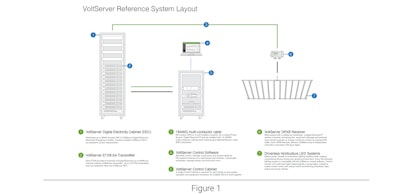
Distribution
![[3] 8 pairs of cable are bundled for easier distribution.](https://img.cannabisequipmentnews.com/files/base/indm/multi/image/2022/01/ACvDE_Final_Version_Page_8_Image_0004.61dddb750ae8f.png?auto=format%2Ccompress&fit=max&q=70&w=400) [3] 8 pairs of cable are bundled for easier distribution.VoltServer
[3] 8 pairs of cable are bundled for easier distribution.VoltServer
The DE cables are run to receivers [4] that are located in the grow rooms. These receivers are a critical component involved in the 530 safety checks that occur each second.
More reliable, lest expensive driverless LEDs
![[4] Cables do not require conduit. Class 2 installation methods, like cable trays or J-hooks, can be used to distribute cable throughout the building.](https://img.cannabisequipmentnews.com/files/base/indm/multi/image/2022/01/ACvDE_Final_Version_Page_8_Image_0005.61dddb7526ee7.png?auto=format%2Ccompress&fit=max&q=70&w=400) [4] Cables do not require conduit. Class 2 installation methods, like cable trays or J-hooks, can be used to distribute cable throughout the building.VoltServer
[4] Cables do not require conduit. Class 2 installation methods, like cable trays or J-hooks, can be used to distribute cable throughout the building.VoltServer
Instrumentation and control
One control cabinet [5, see top], also located in the electrical room, communicates with each individual LED. This provides a sophisticated interface for remotely programming lighting recipes, creating recipe templates for particular plants and plant stages, and defining and redefining zones. Moreover, each LEDs performance is monitored in real-time, and you’ll receive a notification if the LEDs performance falls out of acceptable parameters.
 Quick connects allow you rapidly connect cables to driverless LEDs. Drivers and faulty connections are the primary reasons LED fixtures fail. DE power LEDs have far fewer connections and use remote drivers. This design results in higher reliability and lower maintenance costs.VoltServer
Quick connects allow you rapidly connect cables to driverless LEDs. Drivers and faulty connections are the primary reasons LED fixtures fail. DE power LEDs have far fewer connections and use remote drivers. This design results in higher reliability and lower maintenance costs.VoltServer
Detailed cost comparison (AC vs. DE) for two room facility
Below, we summarize an analysis of the estimated cost of purchasing and installing DE versus traditional AC power. The estimate is based on delivering power from a model facility’s electrical room transformer to a pair of two-tier cultivation rooms. Each room has 96 4’ x 4’ tables illuminated with 720W luminaires.
The cultivation rooms are on opposite lighting schedules, so lights are always off in one room and on in the other. This further reduces CAPEX by sharing power supplies across the two rooms, and it reduces the size of the transformer, as we discuss below.1
Software control of zone definitions, photoperiod, and LED performance monitoring is included in the estimate.
Distribution: an 80% reduction in installation labor
The core savings (shown in Table 1) associated with DE power is the fact that the traditional AC system requires 32X more conduit (1920’ vs 60’). Installing that much conduit accounts for up to 85% of the labor costs associated with installing traditional AC power. By allowing customers to use low-voltage wiring methods, DE reduces installation labor hours by about 80%.
Power supply costs savings and improved reliability
AC powered LEDs also require drivers that transform AC to the DC power used by the LEDs and add an additional $46,656 to the total cost of a traditional AC system. In the DE system, the LED driver function is centralized in the electrical room as part of the transmitters, which use high reliability power supplies.
Centralizing power supplies removes thousands of active electronic components and connections from the grow room. This significantly reduces maintenance costs since those connections and components are the main causes of LED failure.
50% reduction in transformer and switchgear requirements
By centralizing the power supplies and sharing them across pairs of cultivation rooms, the size of the transformer and amount of switchgear is significantly reduced. This is because the power supplies inside the transmitters are shared between the two rooms.
The LEDs in the cultivation rooms have no power supplies. So when calculating the code-based demand load, the calculation is based on the maximum load of the transmitters in the electrical room, which is half what it otherwise would have been if each LED had a dedicated power supply.
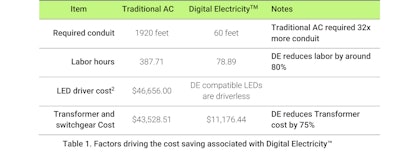
Figure 3 (below) breaks down the total cost into four classes: labor and material for the electrical room, distribution, LED control and instrumentation, and the LED AC-to-DC driver. It shows that in this application, DE reduces the total cost by 32% compared to a traditional AC system. Equipment costs are higher for DE in the electrical room since that where the DE transmitter cabinets are installed. However, that additional cost is more than compensated for by savings in distribution, control and instrumentation, and LED fixture costs.
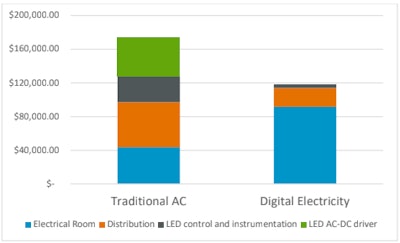
Conclusion
Above we illustrate using a two-cultivation room model that by reducing labor, reducing the cost of LEDs, reducing instrumentation and control cost, and by reducing transformer and switchgear equipment, Digital ElectricityTM reduces the cost of delivering light to plants by 32% or around $18.28 per square foot of canopy.
As the facility grows, the savings from using DE scale into the hundreds of thousands or millions of dollars in savings. For instance, the savings would be up to $1M for 50,000 square feet of canopy, on top of all the other benefits you’ll enjoy when you use DE. Other benefits, shown in Table 2, include photoperiod, zoning, and LED monitoring software, lower electricity costs for customer who must pay for reactive energy, in-rush control which protects equipment, and much lower equipment maintenance costs.
Perhaps the most important benefit is much higher protection for people and equipment from fires and electrical injuries caused by line-to-ground and line-to-line faults.
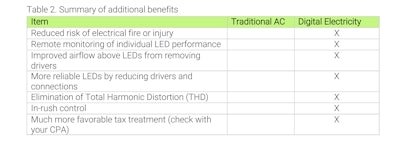
1 This could also be done in the context of traditional AC power, but it would require expensive relay equipment and the resulting conduit would significantly reduce production / building design flexibility.
2 The driver contributes $243 to the retail cost of a 720W LEDs.
